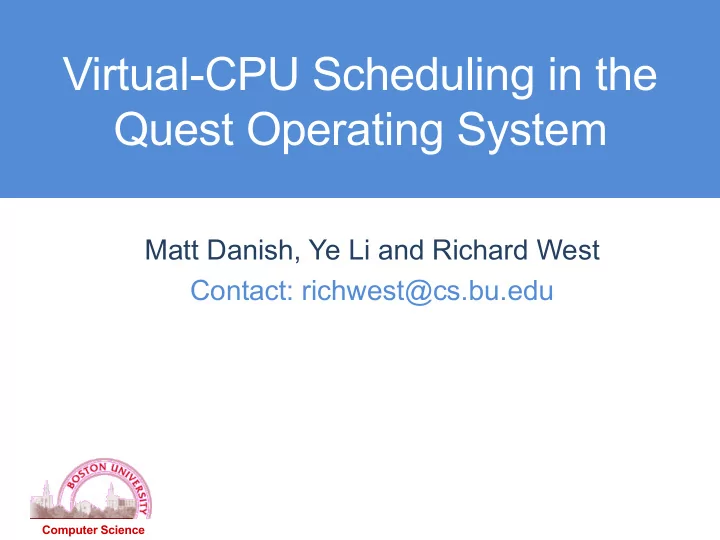

Virtual-CPU Scheduling in the Quest Operating System Matt Danish, Ye Li and Richard West Contact: richwest@cs.bu.edu Computer Science
Goals • Develop system with improved predictability • Integrated management of tasks & I/O events • Enforce temporal isolation between threads
Approach • Introduce “virtual CPUs” for scheduling – Resource containers for CPU usage – Have budgets (reservations) and replenishment periods – • Scheduling hierarchy – Threads mapped to VCPUs – VCPUs mapped to PCPUs
Big Picture
VCPUs in Quest • Two classes – Main → for conventional tasks – IO → for IO event threads (e.g., ISRs) • Scheduling policies – Main → sporadic server (SS) – IO → priority inheritance bandwidth- preserving server (PIBS)
SS Scheduling • Model periodic tasks – Each SS has a pair (C,T) s.t. A server is guaranteed no more than C CPU cycles every period of T cycles • Guarantee applied at foreground priority • Can exceed this utilization at background priority – Rate-Monotonic Scheduling theory applies
PIBS Scheduling • IO VCPUs have utilization factor, V U • IO VCPUs inherit priorities of tasks (or Main VCPUs) associated with IO events – Currently, priorities are ƒ (T) for corresponding Main VCPU – IO VCPU budget is limited to: • V T,main * V U for period V T,main
PIBS Scheduling • IO VCPUs have eligibility times, when they can execute • V e = V e + C actual / V U
Quest Summary • About 11,000 lines of kernel code • About 175,000 lines including lwIP, drivers, regression tests • SMP, IA32, paging, VCPU scheduling, USB, PCI, networking, etc
Experiments • Intel Core2 Extreme QX6700 @ 2.66GHz • 4GB RAM • Gigabit Ethernet (Intel 8254x “e1000”) • UHCI USB Host Controller – 1GB USB memory stick • Parallel ATA CDROM in PIO mode • Measurements over 5sec windows using bandwidth-preserving logging thread
Experiments • CPU-bound threads: increment a counter • CD ROM/USB threads: read 64KB data from filesystem on corresponding device
I/O Effects on VCPUs VCPU V C V T threads VCPU0 2 5 CPU-bound VCPU1 2 8 Reading CD, CPU-bound VCPU2 1 4 CPU-bound VCPU3 1 10 Logging, CPU- bound IOVCPU 10% ATA
I/O Effects on VCPUs
PIBS vs SS IO VCPU Scheduling VCPU V C V T threads VCPU0 1 20 CPU-bound VCPU1 1 30 CPU-bound VCPU2 10 100 Network, CPU- bound VCPU3 20 100 Logging, CPU- bound IOVCPU 1% Network
PIBS vs SS IO VCPU Scheduling t=50 start ICMP ping flood. Here, we see comparison overheads of two scheduling policies
PIBS vs SS IO VCPU Scheduling Network bandwidth of two scheduling policies
IO VCPU Sharing VCPU V C V T threads VCPU0 30 100 USB, CPU-bound VCPU1 10 110 CPU-bound VCPU2 10 90 Network, CPU-bound VCPU3 100 200 Logging, CPU-bound IO VCPU 1% USB,Network VCPU0 30 100 USB, CPU-bound VCPU1 10 110 CPU-bound VCPU2 10 90 Network, CPU-bound VCPU3 100 200 Logging, CPU-bound IO VCPU1 1% USB IO VCPU2 1% Network
IO VCPU Sharing
Conclusions • Temporal isolation on IO events and tasks • PIBS + SS Main & IO VCPUs can guarantee utilization bounds • Future investigation of higher-level policies • Future investigation of h/w performance counters for VCPU-to-PCPU scheduling
Recommend
More recommend